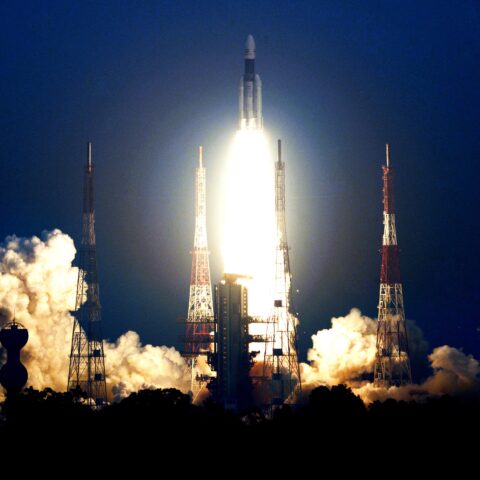A New Space Race? Why the surge of interest in lunar landings matters.

TPI Director Professor Sarah Kreps sat down with space policy expert, Avishai Melamed, to discuss the history of space exploration and the reasons behind the current race to land on the moon.
Sarah Kreps is the Director of the Cornell Brooks Tech Policy Institute and the John L. Wetherill Professor Government at Cornell University.
Avishai Melamed is a Graduate Fellow of the Cornell Brooks Tech Policy Institute and a Ph.D. Student in the Department of Government at Cornell University
Sarah: One of the notable aspects of lunar landings is that there were dozens in the 60s and 70s and then only three in the last several decades and all of them have been in the last five years. Why the surge of interest in lunar landings?
Avishai: The Moon was the most proximate celestial body for us to explore in the 1960s and early 70s. The U.S. conducted quite a few missions there, as have other countries then and since via unmanned rovers. But the Outer Space Treaty pretty quickly established that the Moon wasn’t viable for political control or military application. At the same time, it was also costly and difficult, technologically, to access, limiting the justifications for continued exploration at the end of the Space Race. But since then a new use case has developed, especially as technology advances and more countries reach space, and the moon in particular. These recent launches, and many of the upcoming planned ones, focus on a specific region of the moon: the South Pole. This area is believed to contain important water reserves resources that are pretty much essential for long-term logistics of any future exploitation of the moon. It’s a potential source of drinkable water for astronauts, a resource to use for breathable atmosphere in their habitats, and can be used as a coolant for their equipment. With so many uses for a future sustained presence, it’s not surprising there’s this growing interest in renewed activity on the Moon.
Sarah: Earlier lunar landings essentially avoided the south pole of the moon. Why is it so difficult to land here?
Avishai: The geography of the South is challenging in ways that the equatorial landing sites picked in the past were not. NASA identified the topography of the area, with its deep craters, as a tough landing site. Also, because of the polar location, some of these craters are permanently in the dark, making them hard to map for safe travel. Even the areas that are sometimes sunlit experience major temperature changes, which can also strain some equipment.
Sarah: Can we draw any inferences for why Russia’s latest mission failed and India’s succeeded?
Avishai: It would be pretty fair to say India’s mission was both significantly cheaper compared to the estimates we have for the Russian mission and obviously more successful. The Indian space program is very clearly a priority for the government, as it factors quite a bit into their international prestige. It distinguishes them up as a geopolitical player capable of major technological feats and also simultaneously matters for their domestic politics, where the electoral coalition of the Modi administration is interested in emphasizing its accomplishments ahead of next year’s elections. So, it’s likely that they were able to dedicate a concerted effort towards this project, where Russia might have other concurrent priorities that take precedence and matter more for their status, internationally and at home.
Meanwhile, the Russian program has struggled with chronic corruption, which has persisted despite attempts to reform the national space program. So, it’s not clear the program’s stated resources reflect the actual practical support it received. Also, Russia’s mission was only called Luna 25 because its predecessor Luna 24 was all the way back in the 1960s. It’s been quite a while since they even attempted a project like this, so their overall timeline and the mission’s outcome are indicative of the problems they’re facing.
Sarah: Would you say there’s a new space race or would that be an overstatement?
Avishai: If you mean a space race in the sense of the 1960s, where the efforts were all essentially building toward a singular goal of being first to reach the moon, then no. There’s no clear equivalence to that objective. But there’s definitely a sense of urgency among the major spacefaring countries to develop and demonstrate their capabilities. Whether they hope to access lunar resources or achieve prestigious accomplishments, they would all like to move sooner, rather than later. The most prestige goes to the first achiever, and that requires the increased emphasis on new technologies and applications, as well as bigger goals that we’re seeing now.
Sarah: So, Avishai, the big question, what are your thoughts on extraterrestrial life?
Avishai: I like to think of myself as kind of a skeptic on the topic UFOs and aliens. The Fermi paradox definitely gives us confidence that the conditions for life are out there, but I have yet to see anything that would suggest that it’s anywhere close to us. Hopefully, returning to the moon and exploring more of our solar system can help us learn more about what those conditions are like in our area, though!
To read more on the latest technological, political, and strategic developments in space check out The Promise and Perils of the Space Boom, written by Sarah Kreps, Avishai Melamed, and Ray Jayawardhana and published by The Brookings Institution.
